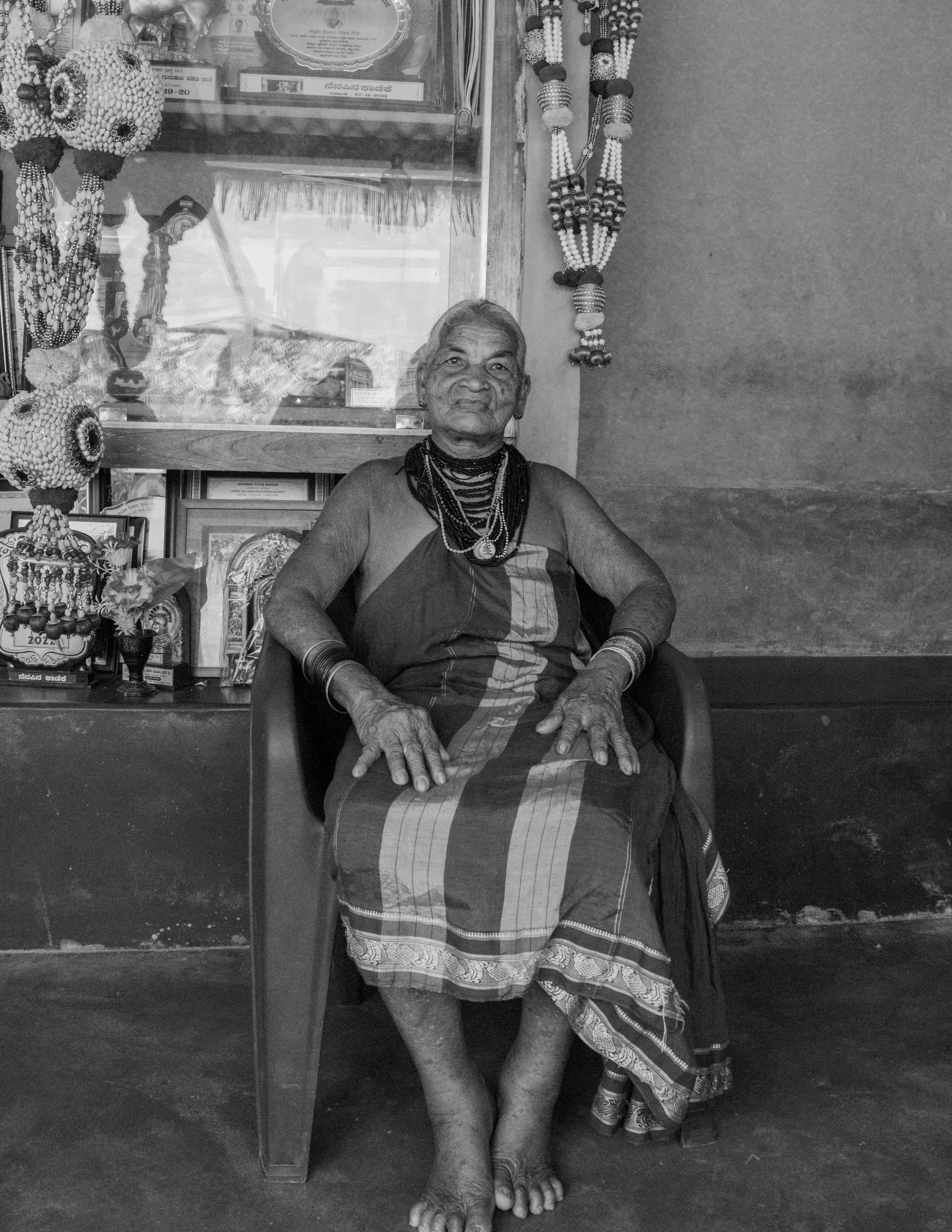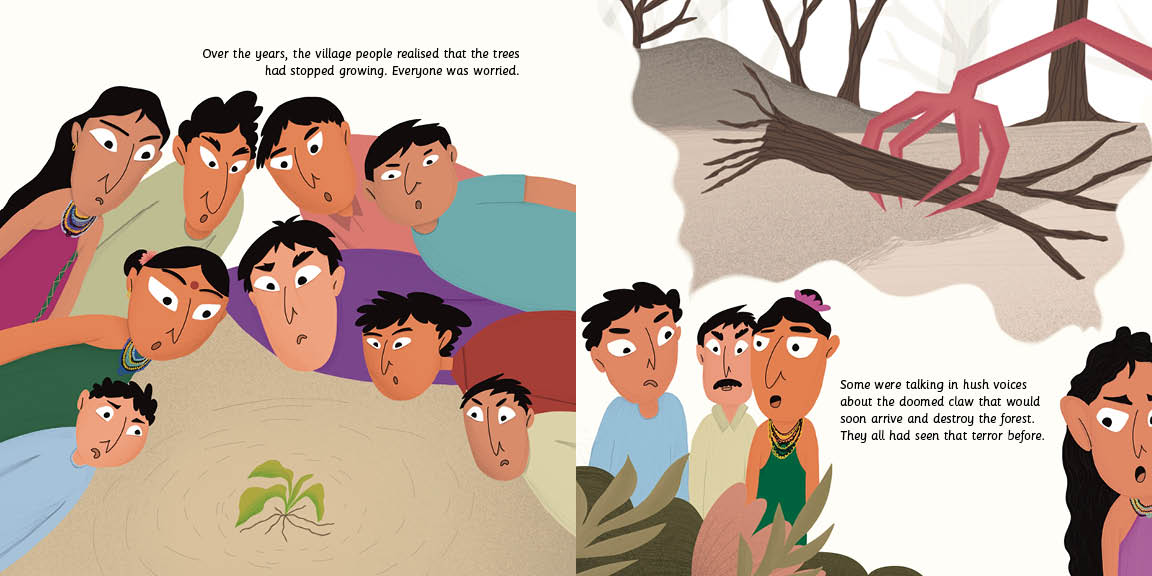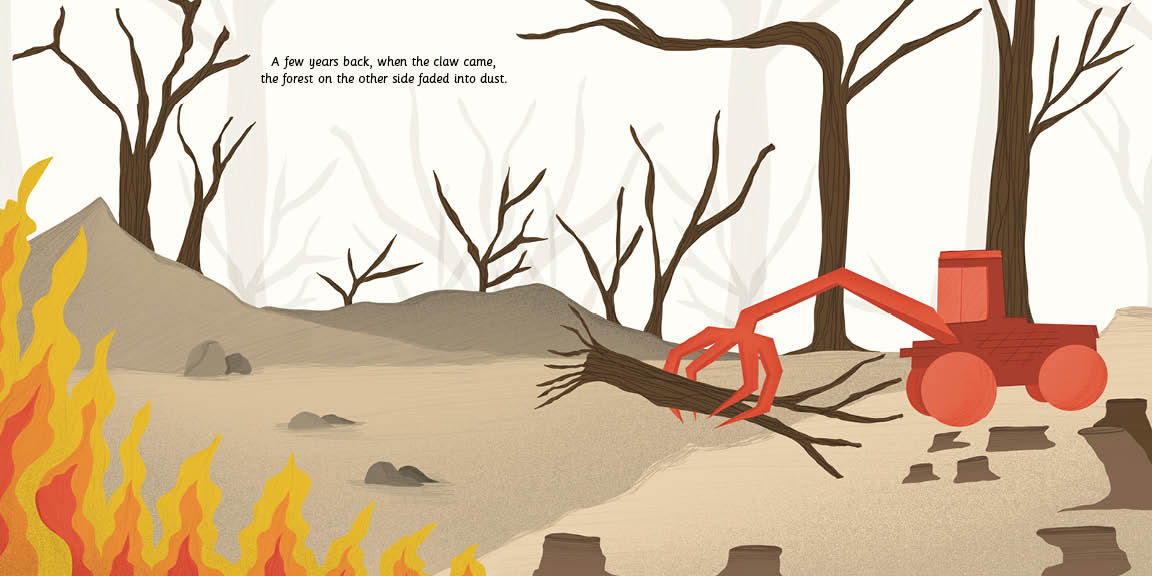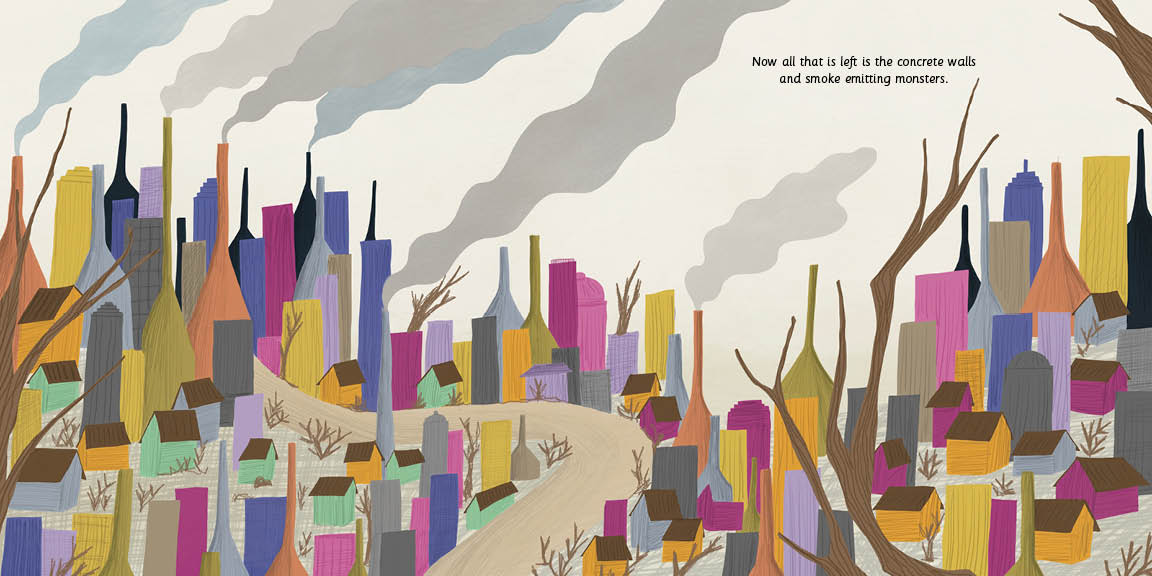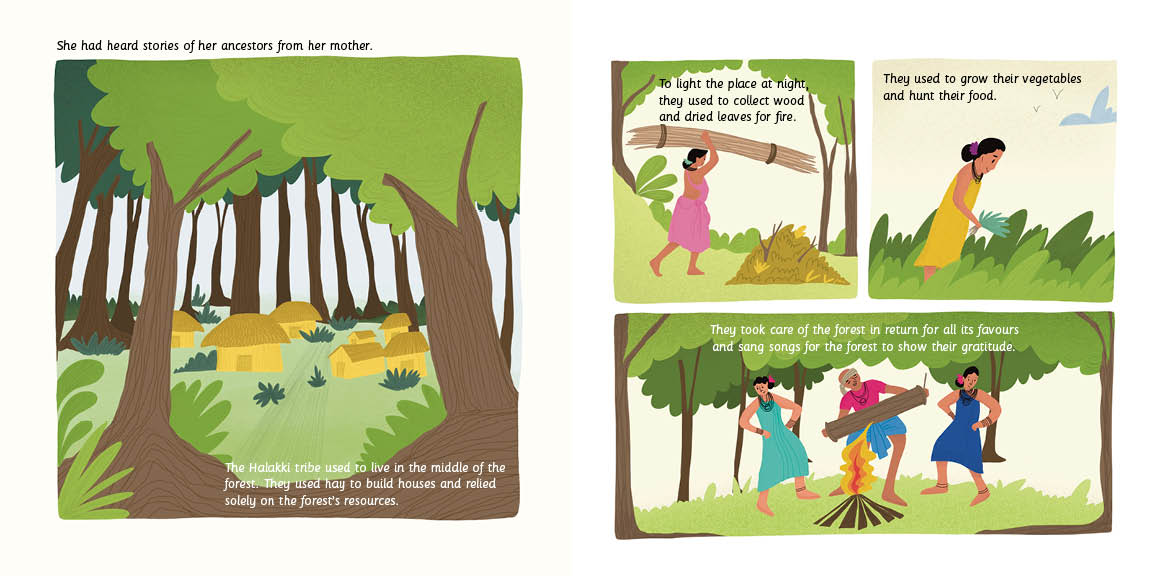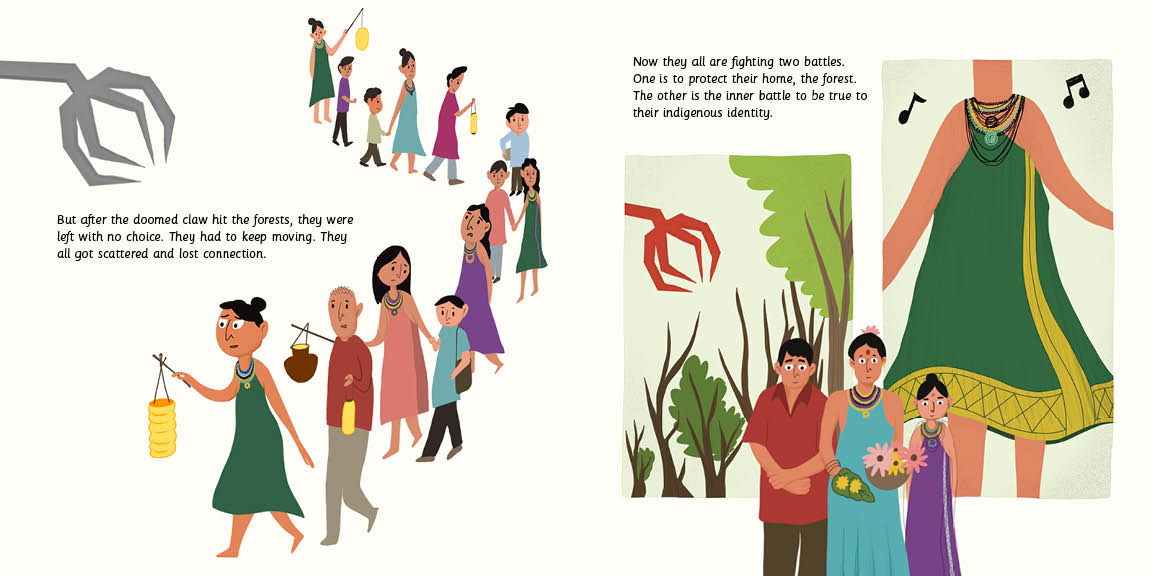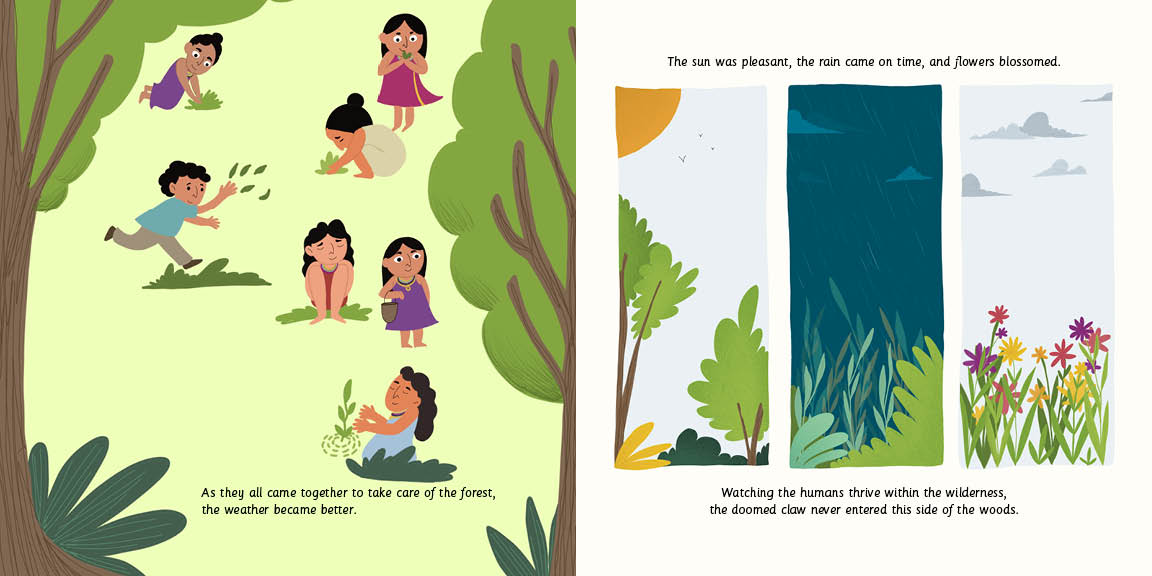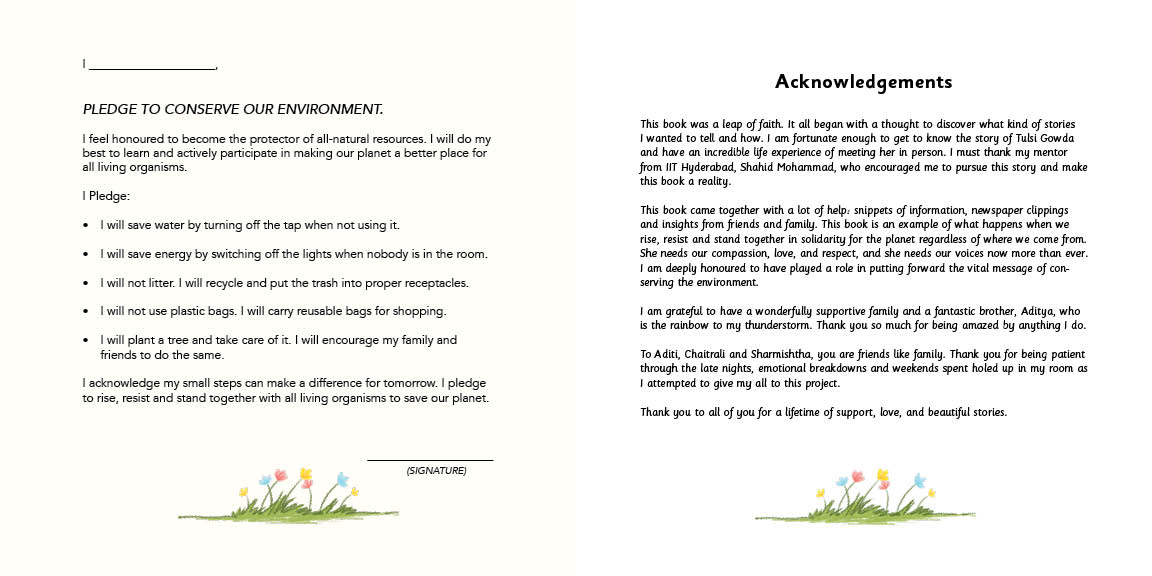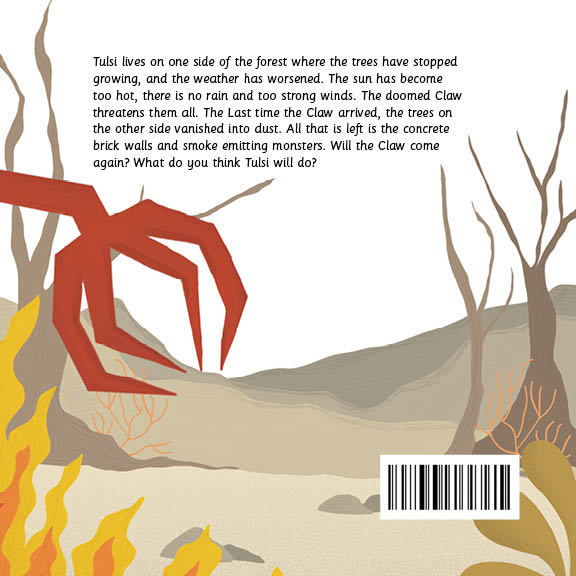UX/ Visual Case Study
UX/ Visual Case Study
UX/ Visual Case Study
ROOTS: Designing an Engaging Story Experience Through Research
ROOTS: Designing an Engaging Story Experience Through Research
ROOTS: Designing an Engaging Story Experience Through Research
How ethnographic research, interviews, and user testing shaped a children's book on environmental conservation.
How ethnographic research, interviews, and user testing shaped a children's book on environmental conservation.
How ethnographic research, interviews, and user testing
shaped a children's book on environmental conservation.


Overview
Overview
Overview
This research investigates the transformative role of visual storytelling in uncovering the stories of unsung heroes. By turning complex narratives into engaging visuals, it highlights the power of imagery in making grassroots contributions more accessible, especially to younger audiences. The children’s picture book 'Roots', based on Tulsi Gowda, an Indian environmentalist, serves as a case study, illustrating how visuals can amplify the impact of environmental movements, turning forgotten contributions into compelling and universally relatable stories.
🎨 Just here for the visuals? Skip the research & jump straight to the artwork!
👉 Go to Visuals
🎨 Just here for the visuals? Skip the research & jump straight to the artwork!
👉 Go to Visuals
🎨 Just here for the visuals? Skip the research & jump straight to the artwork!
👉 Go to Visuals
Approach
Approach
A human-centered UX research approach was essential to ensure cultural authenticity, engagement, and accessibility in Roots. To achieve this, a mixed-method research framework was implemented, emphasizing qualitative depth and iterative refinement.
Ethnographic Research
Ethnographic Research
Conducted on-site visits and interviews in Tulsi Gowda’s village to observe cultural and environmental interactions firsthand.
Comparative Analysis
Comparative Analysis
Reviewed children’s books on environmental themes. To identify market gaps in cultural representation, storytelling format, & actionability.
More than just a book, Roots serves as a gateway for children to connect with environmental responsi-bility, showing them that real heroes exist in their own cultural landscapes.
Visual Storytelling as a Bridge
Visual Storytelling as a Bridge
Complex themes of environmental conservation were distilled into engaging visuals, making them accessible for young readers.
Child-Centric Design & Testing
Child-Centric Design
& Testing
The book’s language, pacing, and illustrations were refined through user testing with children, ensuring readability, engagement, and emotional connection.
The book’s language, pacing, and illustrations were refined through user testing with children, ensuring readability, engagement, and emotional connection.
From Story to Movement
More than just a book, Roots serves as a gateway for children to connect with environmental responsibility, showing them that real heroes exist in their own cultural landscapes.
Finding the Right Story
Finding the Right Story
Finding the Right Story
The selection process began without any strict criteria, aiming to unbiasedly explore grassroots changemakers whose stories needed to be told. However, due to resource and time constraints, a structured filtering process was developed to ensure credibility and feasibility in selecting a compelling story.
Challenges
🔴
Limited documentation on
grassroots workers
🔴
Narrowing Down the List of
Eligible Candidates
🔴
Access to Candidates for
Interviews & Research
Filter criteria
🌱
Credibility check to quickly
validate contributions
🌱
Represent current global
challenges
🌱
Geographic proximity to ensure
in-person interviews
1. 'Seed mother' - Rahibai Soma Popere (Farmer)
2. '2 rupee doctor' - Dr Ravindra Kolhe (Doctor)
3. 'Encyclopedia of the forest' - Tulsi Gowda (Environmentalist)
4. 'Pashu Sakhis' - Friends of the animal (Women empowerment)
5. Sudha Murthy (Philanthropist)
6. Leila Seth (Lawyer/judge)
7. Arunachalam Muruganantham - Padman
8. Sindhutai Sapkal - Mother of orphans
9. Lt. General Zameer Uddin Shah - 'Academic Soldier'
10. Ramanjaneyulu GV (Environmentalist)
11. Dr Ritu Biyani Joseph (Doctor)
12. Ngurang Reena - 'A fight against racism'
13. R Sreelekha: 'Raid Sreelekha' (Police officer)
14. Manjamma Jogathi (Dancer)
15. Ekta Bhyan (Athlete)
16. Chetna Sinha (Entrepreneur)
17. Suhasini Mistry (Social worker)
18. Arvind Gupta (Toy maker)
19. Bhajju Shyam (Gond artist)
20. Dr Tsering Lando) (Gynaecologist)
21. Harekala Hajabba (Fruit vendor)
22. Dr Birubala Rabha (Witch hunter)
23. Chaman lal Sapru (Professor)
24. Bhuri Bai (Artist)
25. Dr K.K. Sarma (Veterinarian)
1. 'Seed mother' - Rahibai Soma Popere (Farmer)
2. '2 rupee doctor' - Dr Ravindra Kolhe (Doctor)
3. 'Encyclopedia of the forest' - Tulsi Gowda (Environmentalist)
4. 'Pashu Sakhis' - Friends of the animal (Women empowerment)
5. Sudha Murthy (Philanthropist)
6. Leila Seth (Lawyer/judge)
7. Arunachalam Muruganantham - Padman
8. Sindhutai Sapkal - Mother of orphans
9. Lt. General Zameer Uddin Shah - 'Academic Soldier'
10. Ramanjaneyulu GV (Environmentalist)
11. Dr Ritu Biyani Joseph (Doctor)
12. Ngurang Reena - 'A fight against racism'
13. R Sreelekha: 'Raid Sreelekha' (Police officer)
14. Manjamma Jogathi (Dancer)
15. Ekta Bhyan (Athlete)
16. Chetna Sinha (Entrepreneur)
17. Suhasini Mistry (Social worker)
18. Arvind Gupta (Toy maker)
19. Bhajju Shyam (Gond artist)
20. Dr Tsering Lando) (Gynaecologist)
21. Harekala Hajabba (Fruit vendor)
22. Dr Birubala Rabha (Witch hunter)
23. Chaman lal Sapru (Professor)
24. Bhuri Bai (Artist)
25. Dr K.K. Sarma (Veterinarian)
1. 'Seed mother' - Rahibai Soma Popere (Farmer)
2. '2 rupee doctor' - Dr Ravindra Kolhe (Doctor)
3. 'Encyclopedia of the forest' - Tulsi Gowda (Environmentalist)
4. 'Pashu Sakhis' - Friends of the animal (Women empowerment)
5. Sudha Murthy (Philanthropist)
6. Leila Seth (Lawyer/judge)
7. Arunachalam Muruganantham - Padman
8. Sindhutai Sapkal - Mother of orphans
9. Lt. General Zameer Uddin Shah - 'Academic Soldier'
10. Ramanjaneyulu GV (Environmentalist)
11. Dr Ritu Biyani Joseph (Doctor)
12. Ngurang Reena - 'A fight against racism'
13. R Sreelekha: 'Raid Sreelekha' (Police officer)
14. Manjamma Jogathi (Dancer)
15. Ekta Bhyan (Athlete)
16. Chetna Sinha (Entrepreneur)
17. Suhasini Mistry (Social worker)
18. Arvind Gupta (Toy maker)
19. Bhajju Shyam (Gond artist)
20. Dr Tsering Lando) (Gynaecologist)
21. Harekala Hajabba (Fruit vendor)
22. Dr Birubala Rabha (Witch hunter)
23. Chaman lal Sapru (Professor)
24. Bhuri Bai (Artist)
25. Dr K.K. Sarma (Veterinarian)
1 . Tulsi Gowda
2. Manjama Jogathi
3. Bhuri Bai
4. Harekala Hajabba
5. M.k.Kunjol
6. Rahibai Soma Popere
7. Dr. Kushal Kanwar Sarma
8. Dr. Ravindra Kolhe
9. Chetna Sinha
10. Birubala Rabha
1 . Tulsi Gowda
2. Manjama Jogathi
3. Bhuri Bai
4. Harekala Hajabba
5. M.k.Kunjol
6. Rahibai Soma Popere
7. Dr. Kushal Kanwar Sarma
8. Dr. Ravindra Kolhe
9. Chetna Sinha
10. Birubala Rabha
1 . Tulsi Gowda
2. Manjama Jogathi
3. Bhuri Bai
4. Harekala Hajabba
5. M.k.Kunjol
6. Rahibai Soma Popere
7. Dr. Kushal Kanwar Sarma
8. Dr. Ravindra Kolhe
9. Chetna Sinha
10. Birubala Rabha
1 . Tulsi Gowda
2. Dr Ravindra Kolhe
3. Manjama Jogathi
4. Rahibai Soma Popere
5. Harekala Hajabba
1 . Tulsi Gowda
2. Dr Ravindra Kolhe
3. Manjama Jogathi
4. Rahibai Soma Popere
5. Harekala Hajabba
1 . Tulsi Gowda
2. Dr Ravindra Kolhe
3. Manjama Jogathi
4. Rahibai Soma Popere
5. Harekala Hajabba
→
→
→
→
→
→
→
→
→
Three step process of implementing the filter criteria's to narrow down and find the perfect story.
Three step process of implementing the filter criteria's to narrow down and find the perfect story.
Three step process of implementing the filter criteria's to narrow down and find the perfect story.
Who is
Tulsi Gowda?
Who is
Tulsi Gowda?
Years with Karnataka Forest Department
+
Years with Karnataka Forest Department
+
Years with Karnataka Forest Department
+
Indigenous Tree Sampling Planted
K+
Indigenous Tree Sampling Planted
K+
Indigenous Tree Sampling Planted
K+
Awards and Recognitions
+
Awards and Recognitions
+
Awards and Recognitions
+
Awarded one of India's highest civilian honors, the PADMA SHRI in
Awarded one of India's highest civilian honors, the PADMA SHRI in
Awarded one of India's highest civilian honors, the PADMA SHRI in
Get to Know Tulsi Gowda
Get to Know Tulsi Gowda
Get to Know Tulsi Gowda
Life of Tulsi Gowda
Why She is Called the "Encyclopedia of the Forest"?
Her advice to the Younger Generation
Life of Tulsi Gowda
Why She is Called the "Encyclopedia of the Forest"?
Her advice to the Younger Generation
Life of Tulsi Gowda
Why She is Called the "Encyclopedia of the Forest"?
Her advice to the Younger Generation
Read the Entire Interview with
Padma Shri - Tulsi Gowda



She said "Trees are our home. If there are no trees, no crops, the weather will be worse, the sun will be hotter, and there will be no rain. What will we do without rain?
We should teach our children about the wild and how essential it is for us to survive.”
She said "Trees are our home. If there are no trees, no crops, the weather will be worse, the sun will be hotter, and there will be no rain. What will we do without rain? We should teach our children about the wild and how essential it is for us to survive.”
Who Are the Halakki Vokkaliga Tribe?
The Halakki Vokkaliga tribe is an indigenous community primarily found in Uttara Kannada, Karnataka. They have a deep-rooted connection with nature, relying on sustainable farming, forest conservation, and oral storytelling to pass down their wisdom.
The Halakki Tribe: Their Identity & Why It Matters
Who Are the Halakki Vokkaliga Tribe?
The Halakki Vokkaliga tribe is an indigenous community primarily found in Uttara Kannada, Karnataka. They have a deep-rooted connection with nature, relying on sustainable farming, forest conservation, and oral storytelling to pass down their wisdom.
Representation in Roots ensures to create a story where Halakki Vokkaliga children feel seen and proud of their roots, rather than feeling the need to blend in to be accpeted by the society.
Representation in Roots ensures to create a story where Halakki Vokkaliga children feel seen and proud of their roots, rather than feeling the need to blend in to be accpeted by the society.
Why This Story Needed to Reach Children?
Tulsi Gowda believes that if we want future generations to coexist with nature, they need to understand that environmental conservation isn’t a separate responsibility—it should be as natural as breathing.
Exploring Different Formats: The Ideation Process
Exploring Different Formats: The Ideation Process
To determine the best approach, multiple 'How Might We' questions were explored:
How might we make environmental conservation relatable to children?
How might we teach this in a way that feels natural, not forced?
How might we create something within our capacity to execute properly?
This led to brainstorming several possible formats:
Educational Video ❌
Rejected because: Videos are passive learning experiences. We wanted something that children could interact with, hold, and revisit without screen dependency.
Educational Video ❌
Rejected because: Videos are passive learning experiences. We wanted something that children could interact with, hold, and revisit without screen dependency.
Game-Based Learning ❌
Rejected because: Games require active digital engagement, which limits accessibility for children with fewer digital resources.
Game-Based Learning ❌
Rejected because: Games require active digital engagement, which limits accessibility for children with fewer digital resources.
Children's Book ✅
Selected because: Picture books provide active engagement, allowing children to follow a narrative, visualize lessons, and connect with a real-life hero.
Children's Book ✅
Selected because: Picture books provide active engagement, allowing children to follow a narrative, visualize lessons, and connect with a real-life hero.
School Workshops ❌
Rejected because: These require physical participation, limiting scalability and long-term engagement.
School Workshops ❌
Rejected because: These require physical participation, limiting scalability and long-term engagement.
Understanding the Landscape: Researching Existing Children’s Books
Understanding the Landscape: Researching Existing Children’s Books
Before developing Roots, a comparative analysis was conducted on 20+ children’s books and documentaries that focused on:
📖 Environmental conservation
📖 Real-life change makers
📖 Indigenous storytelling
The goal was to understand what already exists, what’s missing, and how Roots could fill those gaps.
Key Findings from the Research
Key Findings from the Research
🔍 1. No Representation of Indigenous Environmentalists: Most books on environmental themes feature Western conservationists or fictional characters. Gap Identified: Children aren’t introduced to grassroots-level conservationists from India, especially from indigenous communities.
🔍 1. No Representation of Indigenous Environmentalists: Most books on environmental themes feature Western conservationists or fictional characters. Gap Identified: Children aren’t introduced to grassroots-level conservationists from India, especially from indigenous communities.
🔍 1. No Representation of Indigenous Environmentalists: Most books on environmental themes feature Western conservationists or fictional characters. Gap Identified: Children aren’t introduced to grassroots-level conservationists from India, especially from indigenous communities.
🔍 2. Lack of Action-Driven Storytelling: Many books explained why protecting the environment is important, but few encouraged children to take action. Gap Identified: Children need a story that doesn’t just educate but also empowers them to take small, meaningful actions.
🔍 2. Lack of Action-Driven Storytelling: Many books explained why protecting the environment is important, but few encouraged children to take action. Gap Identified: Children need a story that doesn’t just educate but also empowers them to take small, meaningful actions.
🔍 2. Lack of Action-Driven Storytelling: Many books explained why protecting the environment is important, but few encouraged children to take action. Gap Identified: Children need a story that doesn’t just educate but also empowers them to take small, meaningful actions.
🔍 3. Complex or Text-Heavy Formats: Many books used long paragraphs or technical terms, making them difficult for early readers to engage with. Gap Identified: An engaging, visually rich storytelling approach was needed.
🔍 3. Complex or Text-Heavy Formats: Many books used long paragraphs or technical terms, making them difficult for early readers to engage with. Gap Identified: An engaging, visually rich storytelling approach was needed.
🔍 3. Complex or Text-Heavy Formats: Many books used long paragraphs or technical terms, making them difficult for early readers to engage with. Gap Identified: An engaging, visually rich storytelling approach was needed.
🔍 4. Limited Cultural Authenticity in Illustrations & Language: Existing books that touched on indigenous cultures often lacked accurate representation in illustrations and used generic depictions. Gap Identified: Accurate visual representation matters—children should see real, diverse cultures portrayed authentically.
🔍 4. Limited Cultural Authenticity in Illustrations & Language: Existing books that touched on indigenous cultures often lacked accurate representation in illustrations and used generic depictions. Gap Identified: Accurate visual representation matters—children should see real, diverse cultures portrayed authentically.
🔍 4. Limited Cultural Authenticity in Illustrations & Language: Existing books that touched on indigenous cultures often lacked accurate representation in illustrations and used generic depictions. Gap Identified: Accurate visual representation matters—children should see real, diverse cultures portrayed authentically.
How Roots Fills the Gap
Roots introduces children to Tulsi Gowda, someone they can look up to.
Featuring a Real-Life Indigenous Changemaker
Roots introduces children to Tulsi Gowda, someone they can look up to.
Featuring a Real-Life Indigenous Changemaker
Roots introduces children to Tulsi Gowda, someone they can look up to.
Featuring a Real-Life Indigenous Changemaker
The book doesn’t just inform—it guides children to take part in conservation.
Action-Oriented Storytelling
The book doesn’t just inform—it guides children to take part in conservation.
Action-Oriented Storytelling
The book doesn’t just inform—it guides children to take part in conservation.
Action-Oriented Storytelling
More illustrations, less text, expressive characters.
Visually Engaging, Accessible Format
More illustrations, less text, expressive characters.
Visually Engaging, Accessible Format
More illustrations, less text, expressive characters.
Visually Engaging, Accessible Format
The Halakki tribe’s attire, traditions, and environment are depicted accurately.
Authentic Cultural Representation
The Halakki tribe’s attire, traditions, and environment are depicted accurately.
Authentic Cultural Representation
The Halakki tribe’s attire, traditions, and environment are depicted accurately.
Authentic Cultural Representation
Understanding How Children Read:
Parent & Reader Research
Understanding How Children Read:
Parent & Reader Research
To ensure that Roots would truly connect with young readers and their families, a two-pronged research approach was conducted:
Speaking with Parents – Understanding how they choose books for their children.
Studying Children’s Reading Patterns – Observing engagement levels, comprehension, and interaction with books.
Talking to Parents: What Do They Look for in a Book?
Talking to Parents: What Do They Look for in a Book?
Talking to Parents: What Do They Look for in a Book?
To better understand how parents choose books for their children, interviews with 15+ parents were conducted. The parents had children in the 5-8 age group, the target audience for Roots.
Key Questions Asked:
1. How do you select books for your child?
2. What kind of stories keep your child engaged?
3. Do you prefer books with real-life role models or fictional characters?
4. What topics do you feel are missing in children's books?
5. Does your child prefer to read alone, or do they enjoy being read to?
Top Findings from Parent Interviews:
To better understand how parents choose books for their children, interviews with 15+ parents were conducted. The parents had children in the 5-8 age group, the target audience for Roots.
Key Questions Asked:
1. How do you select books for your child?
2. What kind of stories keep your child engaged?
3. Do you prefer books with real-life role models or fictional characters?
4. What topics do you feel are missing in children's books?
5. Does your child prefer to read alone, or do they enjoy being read to?
Top Findings from Parent Interviews:
🔹 Relatable & Simple Stories Work Best – Parents preferred stories about real people and everyday experiences, rather than abstract or fantasy-based narratives.
🔹 Relatable & Simple Stories Work Best – Parents preferred stories about real people and everyday experiences, rather than abstract or fantasy-based narratives.
🔹 Relatable & Simple Stories Work Best – Parents preferred stories about real people and everyday experiences, rather than abstract or fantasy-based narratives.
🔹 Engagement Over Everything – If a book doesn’t capture attention within the first few pages, children lose interest quickly.
🔹 Engagement Over Everything – If a book doesn’t capture attention within the first few pages, children lose interest quickly.
🔹 Engagement Over Everything – If a book doesn’t capture attention within the first few pages, children lose interest quickly.
🔹 Parents Value Educational Content, But It Must Be Subtle – Books with a strong educational theme (like sustainability) are preferred only if the storytelling is engaging and doesn’t feel like a school lesson.
🔹 Parents Value Educational Content, But It Must Be Subtle – Books with a strong educational theme (like sustainability) are preferred only if the storytelling is engaging and doesn’t feel like a school lesson.
🔹 Parents Value Educational Content, But It Must Be Subtle – Books with a strong educational theme (like sustainability) are preferred only if the storytelling is engaging and doesn’t feel like a school lesson.
🔹 Illustrations Matter as Much as the Story – Parents emphasized that expressive illustrations help children stay engaged and understand the story better.
🔹 Illustrations Matter as Much as the Story – Parents emphasized that expressive illustrations help children stay engaged and understand the story better.
🔹 Illustrations Matter as Much as the Story – Parents emphasized that expressive illustrations help children stay engaged and understand the story better.
🔹 Books with ‘Actionable Takeaways’ Are Rare, But Needed – Parents wanted books that don’t just tell a story but also encourage children to act (e.g., planting a tree, reducing waste, or caring for nature).
🔹 Books with ‘Actionable Takeaways’ Are Rare, But Needed – Parents wanted books that don’t just tell a story but also encourage children to act (e.g., planting a tree, reducing waste, or caring for nature).
🔹 Books with ‘Actionable Takeaways’ Are Rare, But Needed – Parents wanted books that don’t just tell a story but also encourage children to act (e.g., planting a tree, reducing waste, or caring for nature).
Studying Reading Patterns: How Children Engage with Books
Studying Reading Patterns: How Children Engage with Books
Studying Reading Patterns: How Children Engage with Books
To understand how children interact with books, reading sessions with 20+ children (ages 5-8) were conducted. These sessions helped identify engagement triggers, comprehension gaps, and preferred storytelling styles.
What We Observed in Children’s Reading Behaviors:
🔹 Shorter Sentences = Better Engagement – Long paragraphs caused loss of focus; simple, conversational writing worked best.
🔹 Shorter Sentences = Better Engagement – Long paragraphs caused loss of focus; simple, conversational writing worked best.
🔹 Shorter Sentences = Better Engagement – Long paragraphs caused loss of focus; simple, conversational writing worked best.
🔹 Illustration-Driven Storytelling Was More Effective – Children pointed at pictures, asked questions, and reacted more when illustrations played a larger role than text.
🔹 Illustration-Driven Storytelling Was More Effective – Children pointed at pictures, asked questions, and reacted more when illustrations played a larger role than text.
🔹 Illustration-Driven Storytelling Was More Effective – Children pointed at pictures, asked questions, and reacted more when illustrations played a larger role than text.
🔹 Children Engaged More with Stories Featuring a Single Central Character – They found it easier to follow and connect with a story that had one strong protagonist (Tulsi Gowda).
🔹 Children Engaged More with Stories Featuring a Single Central Character – They found it easier to follow and connect with a story that had one strong protagonist (Tulsi Gowda).
🔹 Children Engaged More with Stories Featuring a Single Central Character – They found it easier to follow and connect with a story that had one strong protagonist (Tulsi Gowda).
🔹 Interactivity Increases Retention – Kids remembered more from books that had engaging activities at the end rather than those that just told a story.
🔹 Interactivity Increases Retention – Kids remembered more from books that had engaging activities at the end rather than those that just told a story.
🔹 Interactivity Increases Retention – Kids remembered more from books that had engaging activities at the end rather than those that just told a story.
Shaping the Story: A Blend of Reality & Engagement
Introduces young Tulsi Gowda as a curious child—mirroring the curiosity children naturally have.
Focus on feelings & sensory descriptions—how Tulsi felt the soil, heard the trees, and saw the forest change over time.
Balance authenticity & accessibility, making an important story easy to absorb.
Focuses on small, relatable moments—watching a sapling grow, feeling the soil, observing animals in the forest.
Historical & Cultural Accuracy – Ensuring Tulsi Gowda’s experiences, speech, and cultural background were faithfully represented.
Merge Tulsi Gowda’s real-life story with a simple, engaging structure for children.
Maintains a strong emotional arc—showing her passion for trees, the challenges she faced, and her lifelong dedication to nature.
Simplicity for Early Readers – Complex ideas like afforestation were conveyed through relatable visuals & short sentences.
Add engaging dialogue to make the story feel more interactive for young readers.
Iterative Writing Process: Early Drafts & Revisions
The writing process involved multiple iterations, each informed by feedback from usability testing with children & parents.
🔴 Pain Point 1:
Initial versions had too much text.
Solution: Shifted focus to more visual storytelling, fewer words. Colourful illustrations & character expressions became the main focus.
🔴 Pain Point 2: Some concepts, like afforestation were hard for children to grasp.
Solution: Used before-and-after illustrations instead of long explanations to make complex concepts easier to grasp.
🔴 Pain Point 3: Needed a stronger hook for children to care about the story.
Solution: The final version begins with young Tulsi Gowda's house in the forest and her playing around trees, creating instant connection.
From Story to Movement
More than just a book, Roots serves as a gateway for children to connect with environmental responsibility, showing them that real heroes exist in their own cultural landscapes.



Book Blurb
Book Blurb
Book Blurb
Tulsi lives on one side of the forest where the trees have stopped growing, and the weather has worsened. The sun has become too hot, there is no rain and strong winds. The doomed Claw threatens them all. The Last time the Claw arrived, the trees on the other side vanished into dust. All that is left is the concrete walls and smoke-emitting monsters. Will the Claw come again? What do you think Tulsi will do?
Tulsi lives on one side of the forest where the trees have stopped growing, and the weather has worsened. The sun has become too hot, there is no rain and strong winds. The doomed Claw threatens them all. The Last time the Claw arrived, the trees on the other side vanished into dust. All that is left is the concrete walls and smoke-emitting monsters. Will the Claw come again? What do you think Tulsi will do?
Tools Used:






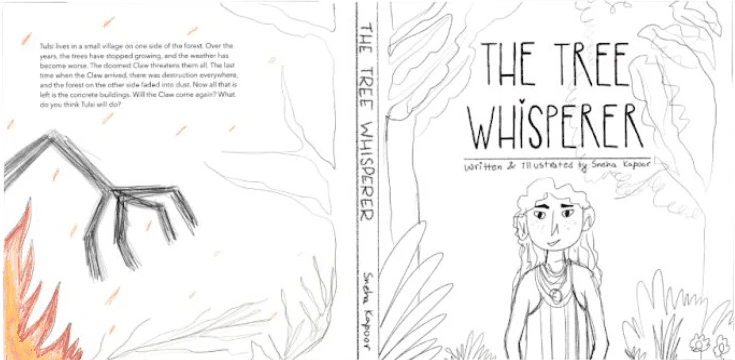














Book Cover Explorations
Book Cover Explorations
Book Cover Explorations
Storyboarding Pages(1-40)
Storyboarding Pages(1-40)
Storyboarding Pages(1-40)



Character Design
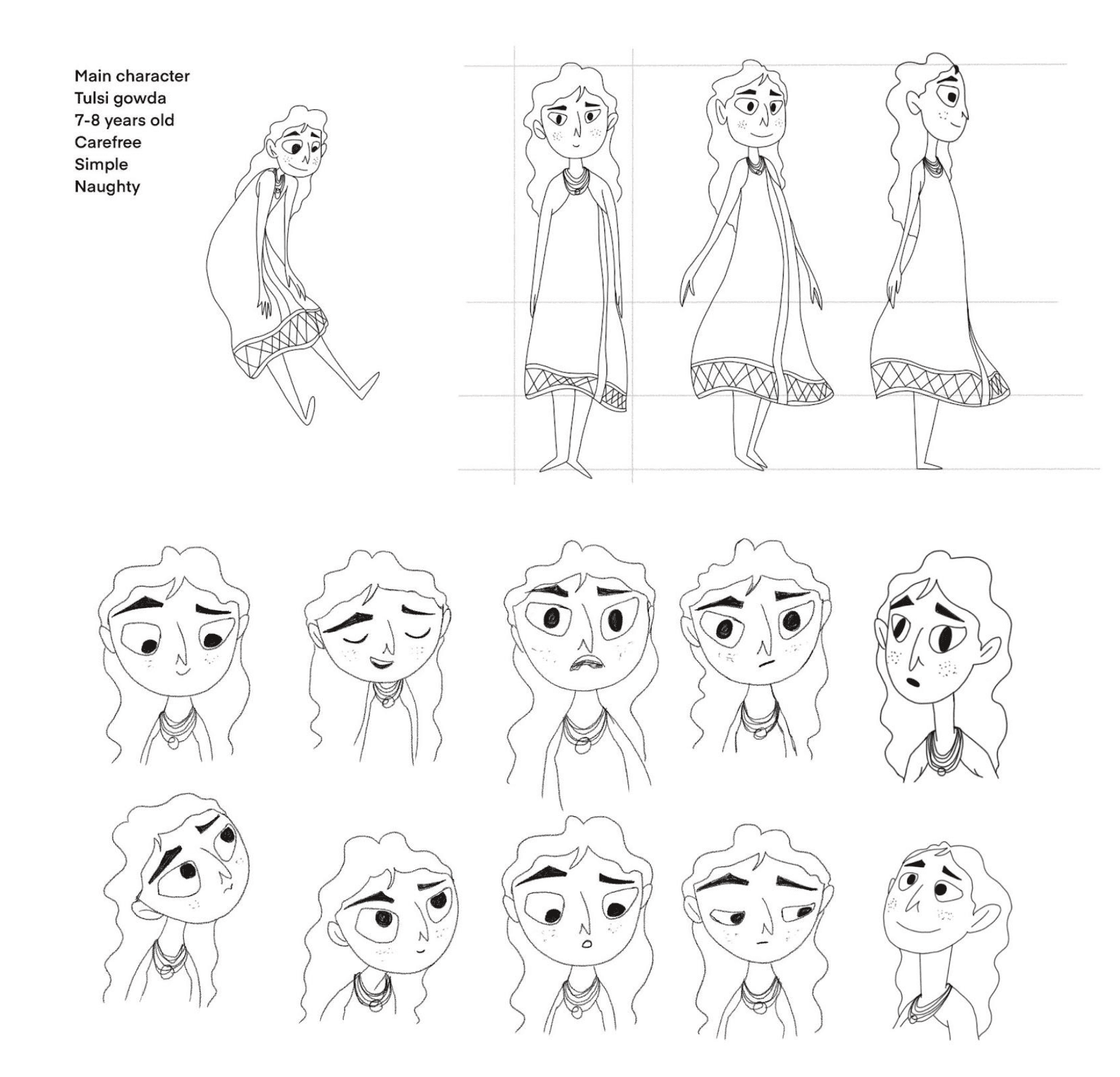


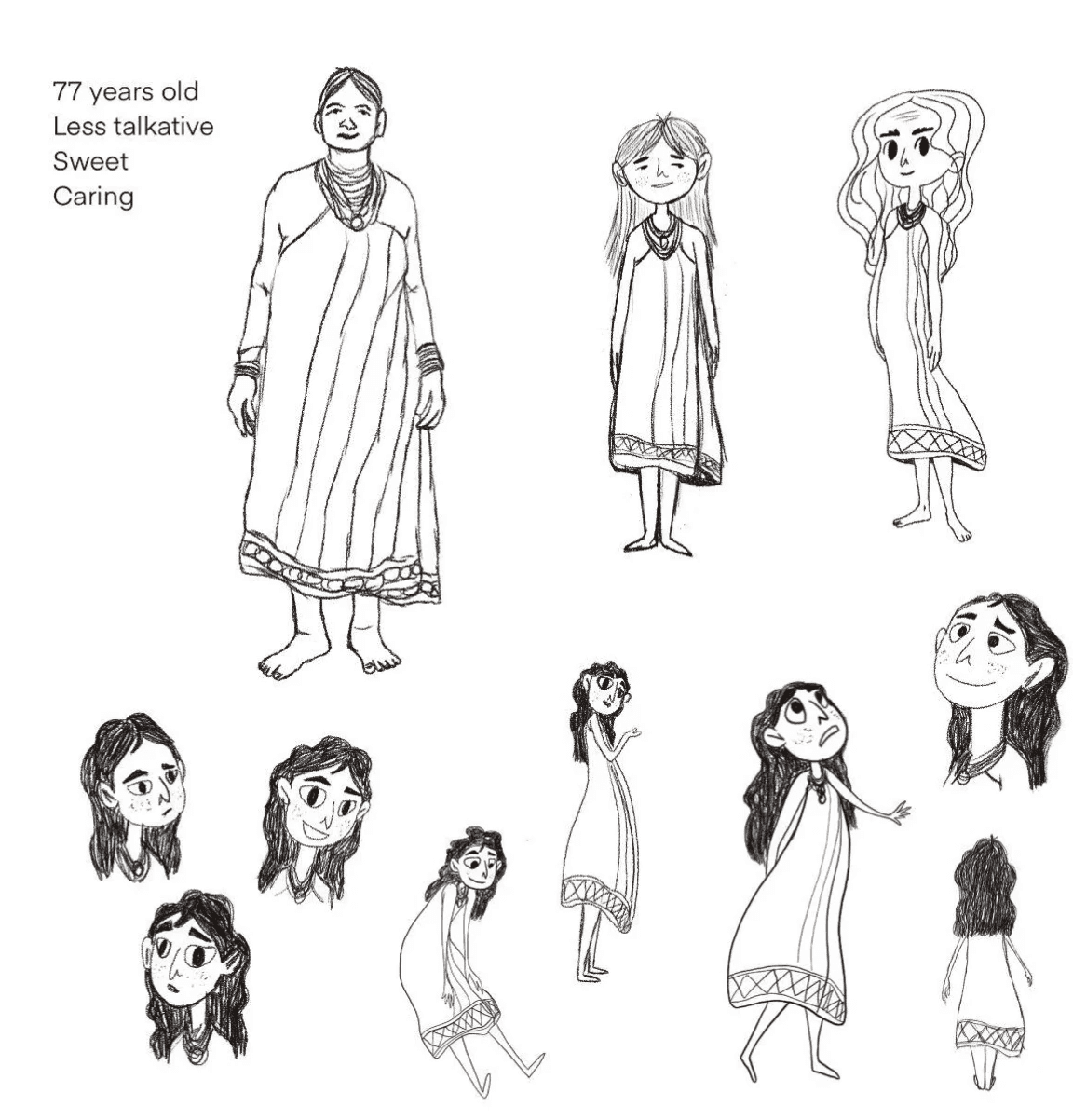
Color Experiments
Color Experiments



Color Palette
I chose a palette that juxtaposes the vibrant tones of flourishing greenery with the muted hues symbolising nature’s destruction. This contrast creates a consistent theme throughout the book, ensuring that neither element overpowers the narrative while portraying the difference.
Typography
For typography, I selected clean, playful fonts that are engaging for young readers yet maintain clear legibility. The chosen typeface complements the illustrations and reinforces the book’s message without distracting from its visual storytelling.








Some Essential Spreads
Some Essential Spreads
Some Essential Spreads
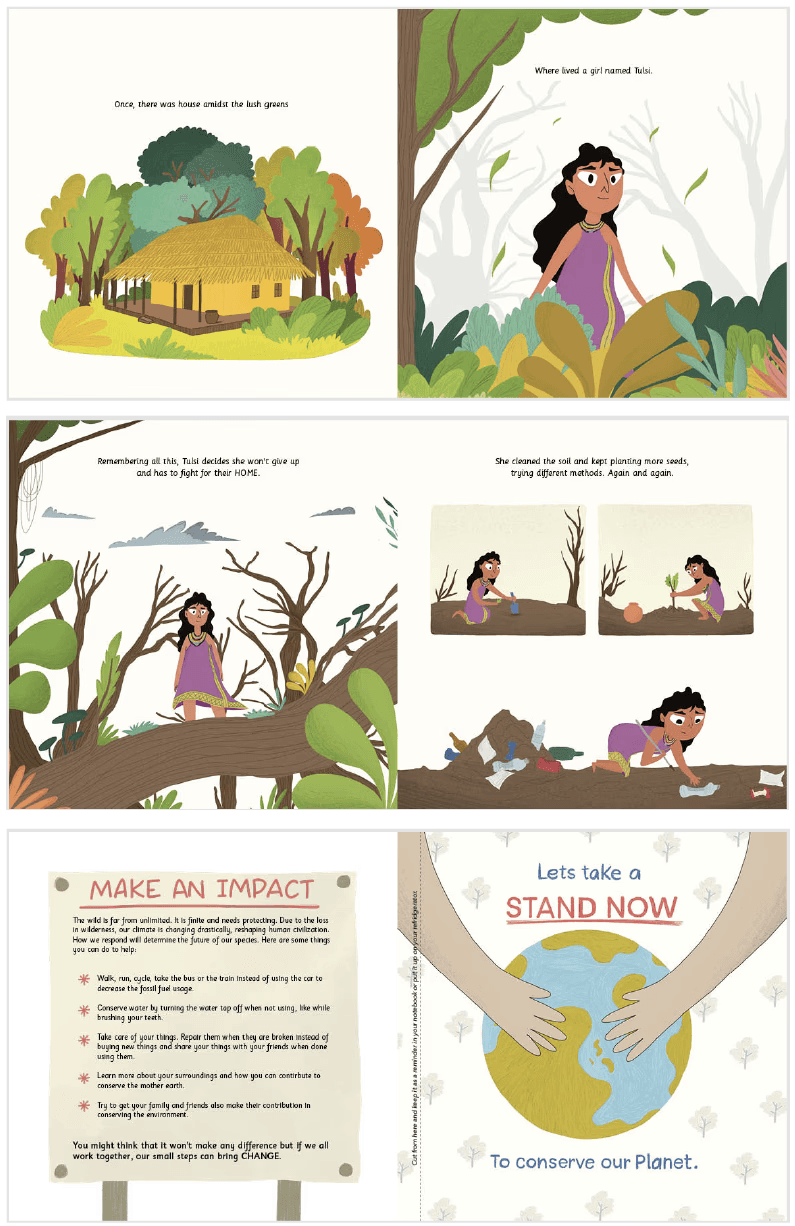



Insights from the Book Reading Sessions
Insights from the Book Reading Sessions
Insights from the Book Reading Sessions
One of the most exciting moments for the kids is when they get to sign their names on the environmental pledge at the end of the book. It’s a small act, but it makes them feel responsible and engaged. I believe it's crucial to encourage these habits early, helping them revisit and nurture their commitment to nature over time.
One of the most exciting moments for the kids is when they get to sign their names on the environmental pledge at the end of the book. It’s a small act, but it makes them feel responsible and engaged. I believe it's crucial to encourage these habits early, helping them revisit and nurture their commitment to nature over time. These sessions also offer a chance to weave in stories about Tulsi Gowda’s life and her cultural background, which helps the children connect more deeply with her and the message. This storytelling sparks their curiosity and gives them a better understanding of how their actions can contribute to environmental conservation. This journey taught me that a project like Roots is not just about telling a story—it’s about planting a seed of thought and letting it grow in the minds of the next generation.
Kids express curiosity about the beaded necklaces Tulsi wears, which leads to conversations about culture and belonging in her Halakki tribe.
Kids express curiosity about the beaded necklaces Tulsi wears, which leads to conversations about culture and belonging in her Halakki tribe.
Tulsi’s life close to nature feels like an adventure to them, making kids rethink "being outside" as more than just playtime but as a way to connect with the world around them.
Tulsi’s life close to nature feels like an adventure to them, making kids rethink "being outside" as more than just playtime but as a way to connect with the world around them.
When asked how they’ll remember the pledge, kids suggest keeping it on the fridge or a "special place," reflecting how rituals can reinforce new habits.
They are most drawn to colorful, action-heavy pages, teaching that visuals can communicate lessons even before words.
When asked how they’ll remember the pledge, kids suggest keeping it on the fridge or a "special place," reflecting how rituals can reinforce new habits.
They are most drawn to colorful, action-heavy pages, teaching that visuals can communicate lessons even before words.
"Why doesn’t everyone listen to trees?" they wonder, as Tulsi’s sensitivity to nature gets them thinking about how adults might be missing the point.
"Why doesn’t everyone listen to trees?" they wonder, as Tulsi’s sensitivity to nature gets them thinking about how adults might be missing the point.
Kids naturally mimic the main character's actions, reinforcing the importance of a relatable and inspiring figure in environmental conservation stories.
Kids naturally mimic the main character's actions, reinforcing the importance of a relatable and inspiring figure in environmental conservation stories.
They show genuine surprise at Tulsi’s life outdoors, learning that caring for the environment can be an everyday action, not just a "big job."
They show genuine surprise at Tulsi’s life outdoors, learning that caring for the environment can be an everyday action, not just a "big job."
Eager to leave their mark, children sign the pledge with pride, feeling like "tree protectors" in the making.
Their excitement often builds as they realize they can help the environment, revealing the joy kids find in simple, actionable ways to make a difference.
Their excitement often builds as they realize they can help the environment, revealing the joy kids find in simple, actionable ways to make a difference.
To know about book reading sessions in schools.
To know about book reading sessions in schools.
To know about book reading sessions in schools.
Character Design
Character Design





Character Design


© Chirpydoodler 2024
© Chirpydoodler 2024
© Chirpydoodler 2024












